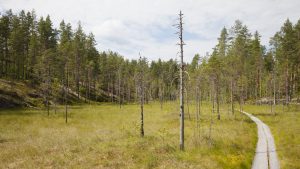What are ecological compensations?
Ecological compensations (biodiversity offsetting) is a mechanism where developers compensate the ecological damage caused by economic activity by restoring or protecting habitats themselves or purchasing compensation from a third party.
What are gains in the context of ecological compensations?
Compensation is carried out by delivering ecological gains. These gains can be produced by performing restoration or nature management measures or, in some cases, averting future losses. Ideally, the objective of compensation is no net loss or even net gain for biodiversity. Voluntary compensations can also be partial instead of no net loss. Ecological gains used to compensate impacts must be additional to existing biodiversity conservation efforts.
What are losses in the context of ecological compensations?
All human activities that degrade, harm or spoil habitats d are regarded as ecological loss.

What is no net loss?
A common objective of ecological compensation is no net loss of biodiversity. This means that all adverse impacts to biodiversity must be compensated for.
What can be compensated?
Ecological compensations are an independent addition in the policy mix for nature conservation. In principle compensation gains should be produced outside protected areas. In addition, compensation principle should not be used to degrade protected areas. Compensations can only be applied to habitats where ecological state can be improved by restoration and nature management measures. Irreplaceable, endangered or vulnerable ecosystems and habitats are always no-go areas where offsetting cannot be applied. In current legislation ecological compensations are mandatory only if Natura 2000 network is impacted.
What is a market for ecological compensations?
Developers needing compensation can carry out compensatory measures themselves or purchase them from a third party. A market for compensations emerges when landowners produce compensation by restoring, managing and conserving habitats and developers purchase these gains as compensations.

What is a habitat bank?
The term habitat bank can refer to a restored land area where credits are sold (especially in the US). Habitat banking often refers to a compensation mechanism where markets emerge. In Finland, a habitat bank is an intermediary, a broker on the market, guaranteeing the quality and maturity of credits.
The Habitat Bank is a Finnish research consortium studying and developing ecological compensations.
Whom do compensations regard?
In Finland, there is not legislation obliging to compensate impacts to biodiversity, apart from requirements regarding Natura 2000 network. Developers can carry out compensations voluntarily.
How can ecological losses and gains be measured?
A broad range of methods have been developed for measuring ecological compensations. In EKOTEKO project, we develop a metrics for measuring ecological value of development sites and compensation sites. The basis for our work is a so-called ELITE index, which measures ecological value of different habitats relative to its natural condition.

How does the requirement to compensate impacts in Natura areas relate to ecological compensations?
In the member states of the EU, compensation is required if a development project affects the Natura 2000 network. It is a network of rare habitat types and core breeding and resting sites for rare and threatened species, and it aims to protect natural diversity in accordance with the EU’s Birds Directive and Habitats Directive. The goal of compensatory measures is to maintain overall ecological coherence of the sites. Compensatory measures can consist of restoring or re-creating the same habitat as degraded, or in exceptional cases proposing a new site. Offsets for birds must be along the same migration path.
In Europe, there have been many cases where impacts to Natura 2000 network have been compensated for but none in Finland.
(References: Similä, J., Primmer, E. ja Salokannel, V. Luonnonarvoja korvaavat toimenpiteet, markkinat ja sääntely. Oikeus 2017(46): 4:416-441.
Pappila, M. Ei nettohävikkiä -periaate ja kompensaatiot biodiversiteetin suojelussa. Ympäristöjuridiikka 4/2017, s. 10-53.)

